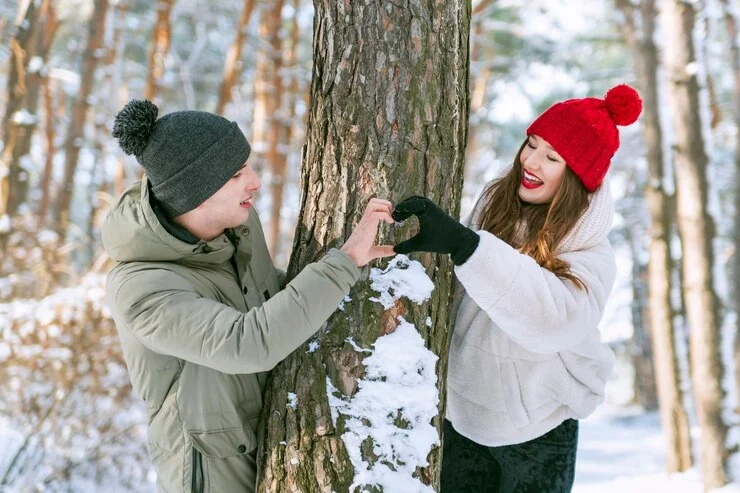As the leaves change and temperatures drop, you may hear talk of “cuffing season” and see friends suddenly coupling up. But what exactly does cuffing season mean? When does it happen and why? What are the pros and cons of these seasonal bonds? Here’s a breakdown of the cultural phenomenon, timing, and tips for making the most of cuffing relationships.
When is Cuffing Season?
Cuffing season typically spans the colder months, from around October through March, with its peak starting in November around Thanksgiving and extending through the December holidays. The phenomenon is driven by an innate human desire for companionship and intimacy during the chilly winter seasons.
The longest nights and shortest days of the year from December to February intensify cuffing instincts. Singles yearn for someone to cozy up with through the holidays and cold weather. Cuffing season usually ends in March when spring arrives and people feel less urge to have a constant companion.
What is Cuffing Season?
The term “cuffing” comes from the notion of being shackled or tied to someone like handcuffs. Cuffing season refers to the annual trend of singles seeking short-term relationships to fulfill temporary needs for intimacy during the fall and winter months.
Motivations include having:
- A date for seasonal events, parties, and activities
- Companionship for staying warm on cold nights
- Someone to show affection and provide emotional support
- A partner for intimacy and sex
- Avoiding pressure for more serious commitment
Unlike summer flings, cuffing connections have a built-in end date that aligns with spring’s arrival. This distinguishes them from organically evolving long-term bonds.
Pros of Cuffing Season Relationships:
While cuffing carries risks like any dating arrangement, potential upsides exist too:
- Satisfies intimacy cravings heightened in winter
- Always having a plus-one for holiday parties
- Consistent companionship when most want to hibernate
- Physical and emotional comfort through winter
- Avoiding the pressure of forever commitment
- Carrying less expectations can be freeing
For singles seeking to fill temporary voids, cuffing partnerships can offer needed comfort and connection before amicably parting ways when conditions change.
Cons of Cuffing Season Relationships:
However, disadvantages are also possible:
- Disrupting usual social circles and routines
- Potential heartbreak when ending as expected
- Less organic beginnings based on cuffing psychology
- Temptation to force connections not truly there
- Distraction from goals and winter hobbies
- Missing better matches that arrive in spring
Cuffing out of scarcity rather than genuine interest can backfire. Don’t sacrifice what you want long-term simply to avoid short-term loneliness.
Tips for Managing Cuffing Season Relationships:
If you do choose to cuff , some recommendations:
- Set expectations clearly about commitment level so no one feels misled when ending it
- Don’t neglect existing friendships and interests – maintain your social life outside the relationship
- Reflect deeply on what you truly want before, during and after cuffing arrangements
- Don’t force connections that aren’t naturally there simply out of cuffing season psychology
- Discuss ahead of time if you will continue dating after winter ends
- Consider alternatives like closer platonic friendships to fill companionship needs
With mutual understanding, cuffing season dating can be an enjoyable way to meet short-term intimacy needs. But reflect carefully – don’t sacrifice lasting fulfillment simply to follow a seasonal trend.
Conclusion
While cuffing may seem like a modern relationship trend, human motivations to couple up during cold, dark winters have primitive roots. Short-term bonds didn’t threaten summer’s priorities of bounty and community. Just don’t forget to ask yourself – is this match right for me year-round?
People Also Ask:
Why do people want to cuff during winter?
The winter cuffing instinct stems from human evolutionary desires for intimacy, affection, warmth, and companionship during harsh cold seasons when food was scarce.
Is cuffing season real?
Yes, cuffing season is a genuine cultural phenomenon, particularly among singles marked by temporary partnerships forming in fall and winter. The psychology and behavior shift is driven by seasonal conditions.
What does it mean to be cuffed?
“Being cuffed” refers to being tied down in a romantic relationship, like handcuffs. It implies the partnership was created specifically for the cuffing season period.
Is being cuffed bad?
Cuffing is neither inherently good nor bad. It depends on whether seasonal dating meets both people’s needs and expectations in a healthy way with open communication. For some it’s enjoyable, others unfulfilling.
Do cuffing season relationships last?
Most cuffing bonds end along with winter, but not all. Some partners defy the time limit and continue into long-term relationships. But approach with the expectation it’s short-term unless stated.

